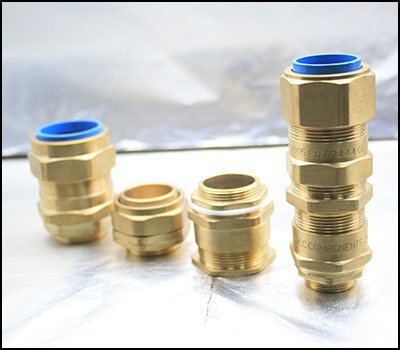In layman terms, a cable gland is a mechanical device used to pass a wire, cable or tube into an electrical equipment in order to seal out dirt, dust and liquids as well as provide strain relief. They are used in conjunction with other electrical installation material and can be manufactured from metallic as well as non metallic substances. As part of the cable and wiring system, cable glands find application in a wide range of industries including automation and electrical instrumentation, telecommunication as well as electrical power industries. The basic purpose of cable glands is to effectively seal the cable to prevent moisture and dust from entering the equipment and to ensure that the equipment is able to retain its original characteristics without dilution or tampering. It also serves a secondary purpose of ensuring the cable is retained within the equipment and to prevent it from being pulled out of the equipment due to any manual or mechanical errors. Although cable glands constitute a small component of the overall electrical installation package, they nevertheless have a very important role to play in maintaining the overall integrity and performance of the equipment. The role and importance of cable glands are further magnified in electrical equipments intended for use in hazardous industrial areas.
Cable glands used in hazardous areas differ significantly from cable glands manufactured for normal industrial use. In order to understand how cable glands can help save time and high installation cost, let us first understand what constitutes a hazardous industrial area. If the ambient atmosphere near or around a site containing electrical equipment has a significant presence of flammable liquids, vapors and gases, ignitable fibers or combustible dust, the risk of fire and explosion is high. Such areas containing electrical equipments that carry high risk of fire or explosion due to the presence of explosive mix of substances in the air are termed as hazardous industrial areas. There are essentially three substances required to be present in order to label an area as hazardous. They are
- Air
- Flammable gases, vapors, mists, dusts
- Ignition source
The atmosphere becomes potentially explosive when a flammable substance mixes with the ambient air creating the potential for an explosion or fire in case of any rise in temperature or even a tiny electric spark. Electrical equipments used in these areas need increased protection to ensure they continue to function even in the eventuality of a fire or explosion occurring in the vicinity.
Using Cable Glands to protect equipment
Installing electrical equipment is a costly and time consuming process, but even more than the economics involved is the greater danger to property and people posed by exploding machinery. Putting it succinctly, with people, property and productivity at stake, there is virtually zero room for error when operating electrical equipment in hazardous industrial area. There are many ways to mitigate the risks associated with electrical installations in hazardous areas, the simplest being not to maintain any electrical instrumentation within the hazardous area altogether, but this might not be practically feasible in some cases. Another strategy is to construct a sealed flameproof enclosure to house electrical machinery, but this can prove to be extremely expensive and time consuming. The third strategy is to reduce the presence of hazardous substances in the ambient air through a series of process improvements. But this can take decades to come about. Meanwhile, electrical instruments including cabling and wiring, installed with it in hazardous areas, need to conform to relevant safety standards to safeguard against any possibility of ignition in a potentially explosive environment.
Saving time and cost with Cable Glands
The easiest, fastest as well as the most cost effective way of ensuring the safety of electrical equipment in hazardous industrial area is to use high quality cable glands. The cost of cable gland is insignificant and negligible when compared to the cost of equipment failure in terms of downtime and the damage to property. Also cable glands are comparatively less time consuming and more cost effective than some of the other protection strategies for preventing explosions in hazardous areas. This is especially true for cable glands that offer high quality and extreme performance reliability. BICC is the preferred manufacturer of electrical components in hazardous areas requiring high quality products and extreme technical proficiency because all their products are rigorously tested to meet all international certification specifications. The advantages of using Cables are many, from lower installation and maintenance costs to a superior level of flexibility and customized solutions. cable glands are designed in strict compliance to global standards and are available in a range of material from stainless steel to brass and nylon. World class manufacturing standards ensure continuity of earthing systems, long lasting performance and greater degree of safety to personnel and equipment working in hazardous industrial areas.
BICC Components Limited (BICC) is an expert and renowned manufacturer and distributor of cable gland, cable cleats, cable connector, cable fitting and cable accessories that are specially designed to save time and high installation cost in Hazardous Industrial Areas. Keeping constant improvement as a goal, BICC group comes up with innovative cable glands and fittings modelled for hazardous area. Proper testing and defect free batch of production with proffering tough and durable cable gland solution is what makes us an expert in delivering complete cable security solutions. To know more, visit https://www.bicccomponents.uk.com/. You can also visit https://www.bicccomponents.uk.com/contact-form/ to solve your queries or get a quote or drop an email to info@bicccomponents.uk.com
 SUBSCRIBE TO OUR BLOG
SUBSCRIBE TO OUR BLOG
